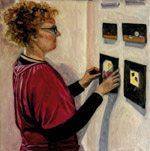How to conquer a Workshop
After creating a workshop for some eager student you need your equipment ready for the day.
Have you got the right case? Have you got a list with the mentioned and fitting equipment?…
BE PREPARED!!! (for almost everything)
Although students are supposed to bring their paints and brushes, bring your own and also your pliers, just in case some students haven’t used their paints for a long time.
Take a box with teabags with you. (Do you always know in advance what kind of tea you’d like? I don’t.) Feel free to take other kinds of drinks.
Have some more things with you: pencils, sharpener and some paper. Who knows who finds them more interesting than paintings or needs a little success.
And never forget somthing to write if you get new ideas (“If an idea doesn’t seem to be absurd in the first place, it’s rubbish.”)




